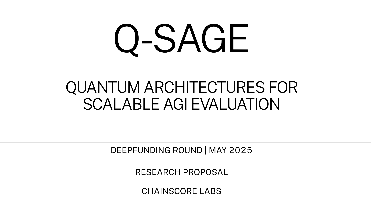
Prasad Kumkar
Project OwnerOversees overall research vision & ensures alignment with OpenCog Hyperon requirements. Designs the formal mapping from AGI components to quantum computing routines, supervises technical deliverables
DEEP Connects Bold Ideas to Real World Change and build a better future together.
Coming Soon
Q-Sage will thoroughly evaluate modern quantum computing paradigms, such as superconducting, trapped-ion, photonic, and topological, for key AGI subsystems in OpenCog Hyperon (PLN inference, ECAN attention, DAS memory). We’ll map AGI tasks into quantum routines (quantum walks, QAOA, VQE), build a Python SDK for hybrid simulation, benchmark on IBM Q, IonQ, Rigetti, and D-Wave with real-device noise models, and deliver a detailed feasibility matrix, cost-benefit analysis, and integration support.
This RFP seeks a technical and experimental assessment of quantum computing architectures in AGI applications. Proposals should explore the practicality and limitations of various quantum approaches — including trapped-ion, superconducting, photonic, and topological quantum computing — in handling probabilistic reasoning, parallel processing, and large-scale knowledge representation. The research could include quantum-classical hybrid simulations and feasibility studies for applying quantum advancements to AGI workloads. Bids are expected to range from $20,000 - $100,000.
During Months 1–2 we will perform an exhaustive literature review and system audit of the four quantum paradigms (trapped-ion superconducting photonic topological). We will collect hardware specs (qubit topologies T₁/T₂ gate times error rates) analyze scaling curves (quantum volume vs. fidelity) and map each platform’s theoretical suitability to key OpenCog Hyperon components (PLN ECAN DAS). We’ll also outline our simulation and experiment strategies (e.g. toy quantum-walk on a mini-AtomSpace QAOA on a small attention-allocation QUBO).
A Research Plan Document comprising: 1/ Tabulated hardware specifications and scaling analysis for each quantum paradigm 2/ Detailed mapping of platform strengths to AGI subsystems (PLN ECAN DAS) 3/ Proposed simulation & experimental protocols with success criteria
$10,000 USD
The review is complete when the Research Plan is approved by internal peer review, covering all four paradigms, with clear experiment outlines and evaluation metrics defined for subsequent milestones.
In Months 3–5 we will build and validate initial theoretical models and small-scale simulations. This includes: 1/ Formalizing PLN inference as a discrete-time quantum walk on an adjacency tensor 2/ Casting ECAN attention allocation into a QUBO and prototyping a depth-2 QAOA circuit 3/ Encoding DAS associative recall as an Ising-model VQE ansatz We will run these circuits in Qiskit/Aer and on small backends (IBM Q 5-7 qubits IonQ 5 qubits) using real-device noise models.
A Technical Progress Report containing: - Pseudocode/mathematical derivations for each QC→AGI mapping - Simulation results (success probability time-to-solution resource costs) - Initial empirical runs on real hardware with basic error-mitigation applied
$10,000 USD
Demonstrated prototype circuits for each AGI task achieving ≥50% of the targeted performance metrics (e.g., ≥70% inference success in 20-step quantum walk, QAOA approximation ratio ≥0.7), and delivery of the Technical Progress Report.
During Months 6–8 we will deepen our experiments by: - Running and benchmarking hybrid quantum-classical loops (e.g. QAOA with classical optimizer VQE with parameter shifts) on mid-size systems (IBM Q 15-27 qubits IonQ 32 qubits) - Comparing performance against optimized classical baselines (graph search simulated annealing) - Testing error-mitigation techniques (zero-noise extrapolation probabilistic error cancellation) on quantum-walk and QAOA circuits
An Expanded Analysis Report including: 1. Detailed benchmarking charts (quantum vs. classical) for each AGI submodule 2. Noise-mitigation results and analysis of depth vs. fidelity trade-offs 3. Refined algorithmic recommendations for each paradigm
$10,000 USD
Delivery of clear evidence that at least one quantum approach outperforms the classical baseline on a toy AGI task (e.g., 10% speedup or 10% higher-quality solution) and publication of the Expanded Analysis Report.
In Months 9–10 we will synthesize all findings into a comprehensive feasibility study: - Build a multi-axis matrix (problem size vs. success probability vs. execution time vs. cost) for each quantum paradigm and AGI task - Quantify logical-qubit overhead for error-corrected operation (surface-code estimates) - Draft strategic recommendations for near-term (NISQ) vs. long-term (fault-tolerant/topological) AGI integrations
A Final Report & Roadmap package comprising: 1. Comparative feasibility matrix and cost-benefit tables 2. Executive summary tailored to SingularityNET/OpenCog decision-makers 3. An integration guide detailing APIs SDK usage and future R&D priorities
$10,000 USD
Submission of the Final Report & Roadmap, with all matrices and guides complete, and stakeholder sign-off from the SingularityNET review panel.
Reviews & Ratings
Please create account or login to write a review and rate.
Check back later by refreshing the page.
© 2025 Deep Funding
Join the Discussion (0)
Please create account or login to post comments.